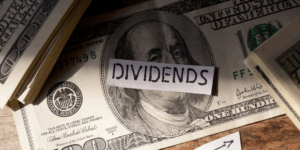
I enjoy investing in dividend-paying stocks. I have always liked Warren Buffett’s quote –”If you don’t find a way to make money while you sleep, you will work until you die.” This quote emphasizes the importance of passive income, such as dividends, interest, or rental income, which allows your money to work for you even when you’re not actively working. There are a lot of great features when investing in dividend-paying stock for the long term, and let’s look at a few:
- Steady Income: Dividends provide a regular income stream, which can be especially valuable in retirement or during market downturns.
- Lower Volatility: Dividend-paying companies tend to be more established and financially stable, often resulting in lower stock price volatility.
- Total Return Boost: Dividends contribute significantly to total investment returns, especially when reinvested.
- Inflation Hedge: Many companies increase their dividends over time, helping to preserve purchasing power.
When you’re holding dividend stocks, depending on your tax bracket or income, it may be wise to look at adding these investments into the appropriate accounts because of the design of dividend-paying stocks.
Efficient Asset Location for Dividend Stocks
To maximize tax efficiency, consider the following:
- Tax-Advantaged Accounts (Best for Dividend Stocks):
- Roth IRA: Dividends grow tax-free, and qualified withdrawals are also tax-free.
- Traditional IRA / 401(k): Dividends grow tax-deferred; taxes are paid upon withdrawal.
- Taxable Brokerage Accounts:
- Use for qualified dividend stocks if you’re in a low tax bracket.
- Consider municipal bonds or growth stocks here, as they may be more tax-efficient.
Summary
Place high-dividend-paying stocks in Roth or Traditional IRAs to avoid annual dividend taxes and maximize compounding.
Now, let’s examine the power of returns, including price returns and dividends, providing a total return.
How Much Have Dividends Contributed to S&P 500 Returns?
From 1960 to 2024, dividends and their reinvestment accounted for approximately 85% of the cumulative total return of the S&P 500
On average, dividends contributed about 34% of the total return over the past 50+ years.
Power of Compounding Through Dividend Reinvestment
Reinvesting dividends means using the cash payouts to buy more stock or fund shares. This creates a snowball effect:
- You earn dividends.
- You reinvest them to buy more shares.
- Those new shares earn dividends, too.
- Repeat over time = exponential growth.
Example:
If you invested $10,000 in the S&P 500 in 1960:
- Without reinvesting dividends: ~$982,000
- With reinvested dividends: ~$6.4 million
That’s the power of compounding in action.
Chris graduated from the University of Maine, where he played hockey on a scholarship, and retired from professional hockey in 2007. In the community, he remains engaged, serving as a youth hockey coach. Chris holds the CERTIFIED FINANCIAL PLANNER™. Outside the office, he enjoys trying new food and wine, reading, traveling, playing golf and hockey, fat tire biking, and donating to local charities. His passions include being a husband and dad, lake life with the family, watching his son and daughter play sports, and spending time with his wife. To learn more about Chris, connect with him on LinkedIn.
Heisten Financial, LLC is a registered investment advisor with the SEC. Information presented is for educational purposes only and does not intend to make an offer or solicitation for the sale or purchase of any securities, and past performance is not indicative of future results. Investments involve risk and are not guaranteed.
